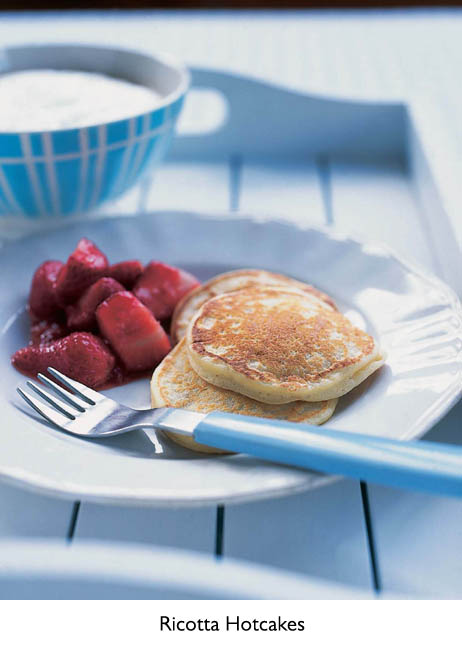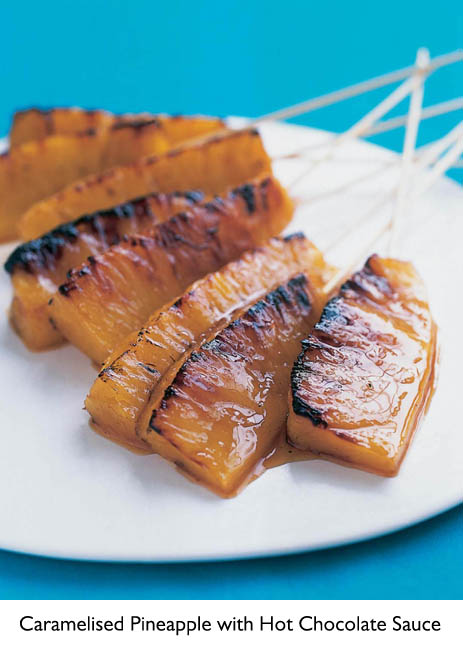Forever Summer (23 page)
Authors: Nigella Lawson

White Chocolate Ice Cream with Hot Blackberry Sauce
Cheesecake Ice Cream
Margarita Ice Cream
Honey Semifreddo
Vin Santo Ice Cream with Cantuccini
Brioches
Red-Hot Chilli Syrup

RICOTTA HOTCAKES
These are breakfast pancakes summer-style, ridiculously light, and lemony somehow even without the addition (for a change in this book) of lemon. If you imagine the flavour of cheesecake combined with a texture that’s best, if wordily, described as a kind of souffléed griddle cake, you’re somewhere near getting the measure of these. My tip, however, is to cut to the chase and make them yourself. Serve, outside if weather and property ownership permits, with some chopped ripe strawberries, partially crushed with a fork, tumbling on top. There is a vocal syrup-dousing contingent in my house, but in my view it mars their fabulous delicacy and, besides, the accompanying fruit allows you to delude yourself that these are healthy.
250g ricotta cheese
125ml semi-skimmed milk
2 large eggs, separated
100g plain flour
1 teaspoon baking powder
pinch salt
2 teaspoons groundnut oil
to serve:
250g strawberries, chopped (or other berries of your choice, of course)
Put the ricotta, milk and egg yolks into a bowl and mix well to combine. Stir in the flour, baking powder and salt and gently whisk to make a smooth batter.
Beat the egg whites until they become foamy – this isn’t hard work even, whisking by hand, which is all that’s needed here – and then fold them into the ricotta mixture.
Heat the oil in a large frying pan and drop in heaped dessertspoons of batter. Cook the pancakes for about 1 minute until golden and then flip them over and cook for another minute. Keep the cooked pancakes warm, by tenting with foil on a large warmed plate, while you work your way through the batter, and then serve with syrup – if you must – and strawberries.
Makes about 25.

CARAMELISED PINEAPPLE WITH HOT CHOCOLATE SAUCE
There’s no other way to put this: these are fruit kebabs. I know how this sounds, but that’s not how they taste.
Now that we’ve got that over with, I’ll go on: these skewer-threaded chunks of pineapple are sprinkled with sugar and blitzed on the barbecue or under the grill till that absurdly yellow, tropical-sunshine flesh is scorched a deep, golden brown. Just when you thought it couldn’t get any better, there is more. You make a thick, dark coconut-rum-deepened chocolate sauce and dip the pineapple into it as you eat. For hygiene’s sake, and it’s not often you’ll hear me saying that, it might be wise to give each person their own little bowl of molten, Malibued chocolate sauce for repeated, fondue-style dunkings, though you can simply stick a ladle in a big bowl of the stuff and let everyone spoon the sauce over the pineapple, on their plates, as they eat. To make this less a Barbie-fest, however, you can forget the bamboo skewer element and simply sugar and grill pieces of pineapple and serve them up to be eaten relatively elegantly, with knife and fork, a jugful of hot chocolate sauce on the table alongside.
1 ripe pineapple
approx. 250g demerara sugar
for the chocolate sauce:
200g dark chocolate, minimum 70% cocoa solids
125ml Malibu
120ml double cream
14 bamboo skewers soaked in cold water to stop them catching fire in the heat of the barbecue or grill
Preheat the grill or barbecue. Cut the top and bottom off the pineapple and, working vertically, slice the skin off the fruit. Cut into quarters and then into about three pieces again lengthways so that you have wedges of pineapple. Cut out the woody core and thread the wedges on to the soaked bamboo skewers lengthways and arrange these in a shallow dish.
Put the chocolate, broken up into pieces, into a thick-bottomed pan along with the Malibu and melt over a low heat. Then, stirring, pour in the cream, plus any juice that has gathered from the fruit. When the sauce is thick, smooth and hot, pour into a bowl with a ladle, or enough little bowls to give one per person.
Lay the pineapple kebabs on a sheet of foil and either grill or barbecue the pineapple, thickly coating it with demerara sugar first, until it caramelises and scorches in the heat.
Take off the barbecue and lay them on a large plate and let everyone take them as they want, dipping the pineapple skewers into the hot chocolate sauce as they eat.
Serves 6–8.

BANANA AND BUTTERSCOTCH UPSIDE-DOWN TART
I normally have a firm rule: I don’t write recipes for, or cook food, I don’t absolutely love to eat myself; but I have to own up to a teensy little problem I have with cooked bananas. You might wonder why, then, I even bothered making this warm, gooey, caramel-sticky banana tart, but my sister requested it once and, as we all know, family life requires a tact and diplomacy that at times must overrule personal prejudice.
In truth, I did rather like it – but only straight out of the oven, before the bananas have time to cool to pungent mushiness. And in fact, you shouldn’t leave it lying around wherever you stand on the cooked banana question: the pastry – which, before you start panicking, is bought – will become soggy if you don’t eat it as soon as it’s cooked. Not that this poses a problem: for the record, of all the puddings I’ve made for this book, this one was polished off fastest.
375g ready-rolled butter puff pastry
50g unsalted butter
75g caster sugar
1 tablespoon golden syrup
1 tablespoon double cream
3–4 bananas
Preheat the oven to 200°C/gas mark 6.
Cut a round of pastry, using a 20cm tarte tatin dish as your guide, and put in the fridge to use later.
Place the tarte tatin dish over a medium heat on the hob and melt the butter, then add the sugar, syrup and cream and whisk for a couple of minutes on the heat to make a thick butterscotch sauce.
Now, take this off the heat, and slice the bananas into 1cm thick rounds. Arrange the bananas in the slightly cooled sauce, and put the cut round of pastry over the top tucking the edges down well and sealing them so that the sauce cannot bubble up.
Bake for 20–25 minutes, by which time the pastry will have puffed up and turned golden brown. Take the dish out of the oven and place a plate over the top and very carefully turn the whole thing upside-down. The sight that meets you is a splendid one: the sauce-sticky, oven-blistered logs of banana forming a bronzey golden crown. And should any of these butterscotch-covered slices of banana be dislodged and stuck to the pan, don’t get alarmed: just spatula them off and tuck them back in their rightful place. For absolute pleasure, eat with vanilla or coconut ice cream.
Serves 4–6.
GINGERED AND MINTY FRUIT SALAD
I hesitate to give a recipe for fruit salad – by which I mean that there is no need to follow my instructions to the letter. Use the fruit you can find in whatever proportion pleases you. I find, in Middle-Eastern stores at any rate, you can get lychees and pomegranates in summer, but if you can’t don’t worry: consider some chunked watermelon instead. The ginger and mint in the syrup make this wonderfully refreshing; but don’t worry, both these elements, along with the syrup in which they’re infused, are light. I love this not just as a pudding, but for a late-morning summer’s weekend breakfast – and at regular intervals during the day besides.
75ml water
45g caster sugar
3cm piece fresh ginger, peeled and roughly chopped
small palmful mint leaves, plus some for snipping over later
juice of half a lime
1 galia melon
1 honeydew melon
1 pawpaw
300g lychees, if available
2 white peaches
seeds from half a pomegranate, if available
Put the water and sugar in a tiny saucepan (I use one of those little copper ones made for melting butter in) and bring to the boil. Let boil for 5 minutes and while the syrup’s bubbling away, put the chopped ginger and mint leaves in a small bowl or ramekin. When the five minutes are up, squeeze in the lime juice and then pour the syrup over the ginger and mint and let cool.
Then you can get on with the salad. For this you need two bowls, one for serving the fruit salad in and one for the detritus. Halve the melons, scoop the seeds into the non-serving bowl and using a melon-baller (please, indulge me) gouge out curvy pieces of melon. When the fruits are used up, squeeze the empty skins to get all the melon juice on to the pieces of fruit. Halve the pawpaw and scoop out the seeds into the detritus bowl and use the melon-baller to carve out more pieces of fruit, squeezing out the emptied skins as you did with the melons. Peel and stone the lychees and add these to the fruit bowl. Holding the peaches, one by one, over the rest of the fruit, cut out small segments and let them drop down over the rest of the fruit as you go.
Pour the cooled syrup into the detritus bowl and strain this over the fruit salad. Now add the pomegranate seeds. The best way of getting seeds out of a pomegranate is to hold a pomegranate half, seed side down, over the fruit bowl and then whack it with a wooden spoon. Nothing much will happen at first, but after a few thwacks, the seeds will rain down upon your salad most satisfyingly.
Chop a few mint leaves finely and scatter over. That’s it.
Serves 6–8.
ANGLO-ITALIAN TRIFLE
I don’t think I could write a book that didn’t include a recipe for trifle somewhere – and this, I tell you, is the trifle to end all trifles. The shiny black of the berries, the soft whiteness of the mascarpone above them and the golden toastiness of the almonds on top, make it, in the first instance, beautiful to look at. But the key element here is ease: unlike with other trifles, there is no caution-requiring cooking of custard, which however delicious, has its stresses. In fact, the only cooking whatsoever is a little heating of some jam on the stove. The Anglo factor is provided by the trifle sponges, jam and hedgerow-redolent fruit; the amaretti, limoncello – or any other lemon liqueur – and tiramisù-like eggy mascarpone layer fulfil the Italian side of the partnership.
I use blackcurrant rather than blackberry jam, simply because I want a more jellied, less pippy smearing between the sponges, but it wouldn’t really matter which you go for. Similarly, feel free to use rum in place of the limoncello. It’s just that I find it hard to come back from holiday in Italy without lugging strange lemon-shaped bottles of local liqueurs, and then want to justify the effort by finding some use for them in the kitchen.
